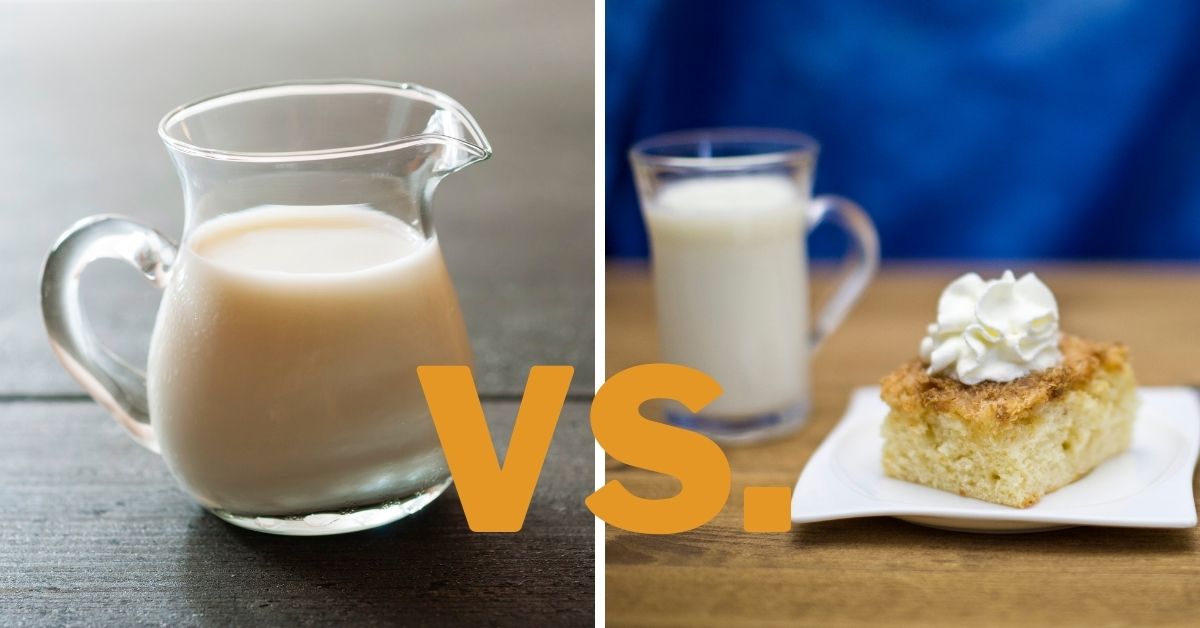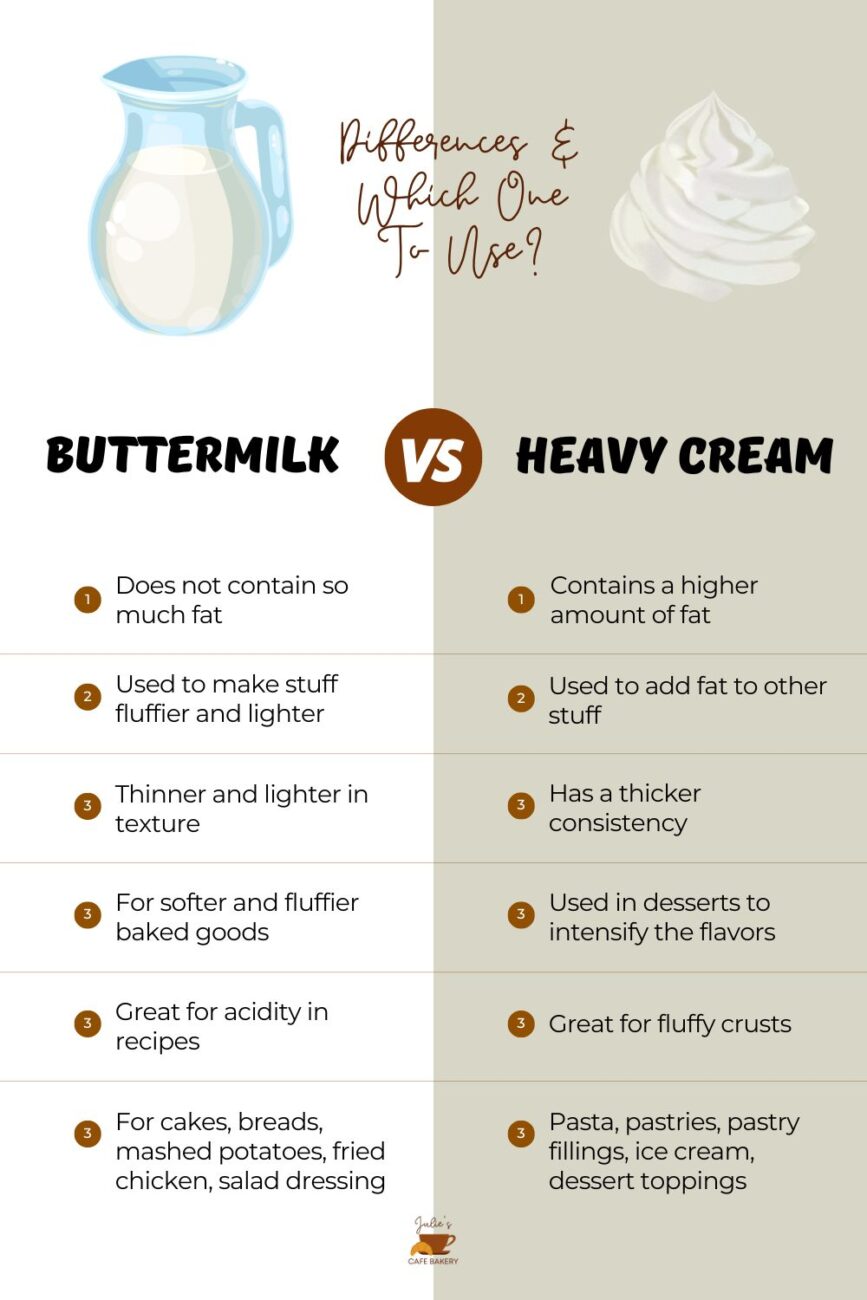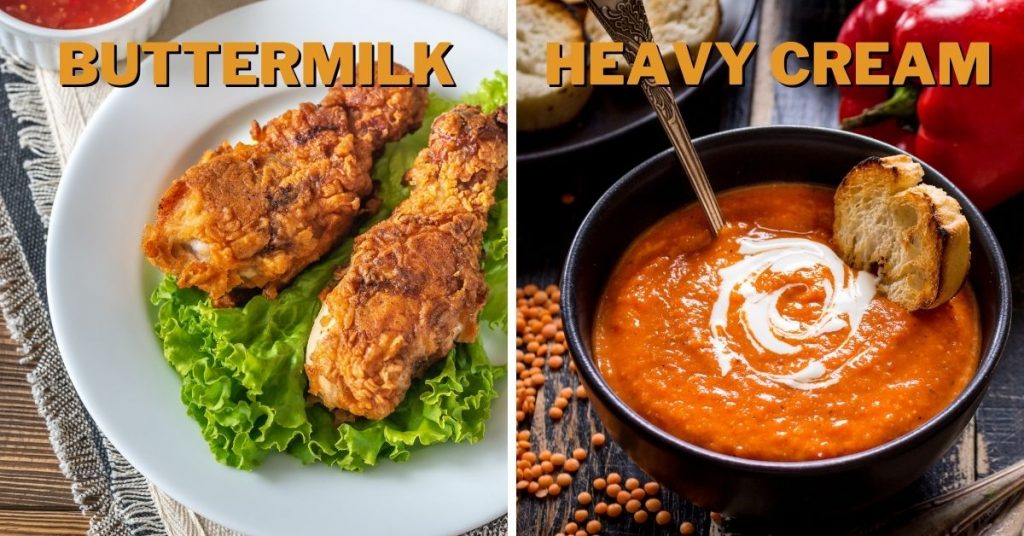Buttermilk vs. Heavy Cream: Differences & When To Use Which

Buttermilk and heavy cream are sometimes used interchangeably, meaning they have many similar features. However, they cannot always serve as a substitute for one another, which means that they also have some significant differences that make them distinguishable. So, what are the actual differences between buttermilk and heavy cream?
Heavy cream is known to contain more fat, which is why it is usually used to add fat to other stuff. On the other hand, buttermilk does not contain so much fat, so it is used to make stuff fluffier and lighter. Sometimes, it is possible to use them interchangeably if you know how.
You need to know the features of buttermilk and heavy cream before using them as substitutes. Otherwise, you will end up with a completely ruined recipe, and that is definitely not what you are looking for. Therefore, in this article, I have compared buttermilk and heavy cream so you can learn which one is more appropriate for a certain occasion.
Buttermilk and heavy cream are not the same!
Even though they have many similarities, buttermilk and heavy cream cannot always be used interchangeably.
For instance, buttermilk has a lighter structure than heavy cream, meaning it will give your recipes a lighter texture. On the other hand, heavy cream contains more fat, which usually contributes to the fat levels in your recipes. Considering this, it is obvious that they cannot always be used as substitutes for one another.
Differences between buttermilk and heavy cream
As I already said, there are many similarities between buttermilk and heavy cream, and they can often substitute for one another. However, they also come with a lot of differences, and these differences make them suitable for different purposes. To use them correctly, you need to familiarize yourself with their actual properties and learn how their differences affect the recipes in which you include them.

Ingredients
Both buttermilk and heavy cream are made of cow’s milk. However, in the case of buttermilk, there is low-fat milk in a combination with fermented lactic acid bacteria. Store-bought and homemade buttermilk can differ in ingredients, but they still have the same texture.
For instance, homemade buttermilk is usually made only from heavy cream. However, this is the original recipe for buttermilk, and not many people nowadays tend to make buttermilk from scratch. That is why the use of cultured buttermilk is nowadays widely spread.
On the other hand, heavy cream is made with whole milk and butter. Since these ingredients are known for their high-fat content, it is logical that heavy cream would be heavier in texture. That is why heavy cream is usually added to make recipes richer in fat.
Nutritional values
Since they have very similar features, you cannot see significant differences in their nutritional values. [1] Namely, heavy cream is slightly higher in the number of calories in comparison to buttermilk.
In addition, heavy cream is richer in calcium but does not contain vitamin C as buttermilk does.
Also, heavy cream contains slightly higher levels of cholesterol but significantly lower amounts of sodium. Considering these facts, the nutritional values do not mean much since the differences are minimal.
Texture and flavor
On the outside, buttermilk and heavy cream look pretty much the same. However, looking closer and tasting them, you will notice some slight but important distinctions.
Buttermilk contains less fat than heavy cream, so it is thinner and lighter in texture. On the other hand, heavy cream has a thicker consistency due to the higher amount of fat, and it is usually used to add fat to different recipes that require it.
Regarding flavors, buttermilk is known to have a tangy flavor, while heavy cream is sweet and creamy. In addition, if you pay attention, you will notice that buttermilk is slightly yellow, while heavy cream is purely white.
Can you substitute buttermilk and heavy cream one for another?
To be sure when it is okay to substitute buttermilk for heavy cream, or vice versa, you need to know when they are suitable for use.
There are recipes suitable for buttermilk but not for heavy cream, and you need to know details like these if you do not want to ruin and waste your food. That is why it is important to learn what recipes allow both buttermilk and heavy cream so you will be safe when you need to use one of them.
To make your cooking or baking easier, it is wise to learn where buttermilk and heavy cream are most commonly used. You will also learn how their properties work in combination with other ingredients, so you will be more aware of how you use them.
When do you use buttermilk?
Buttermilk is a more suitable for baked goods that need a softer and fluffier texture. Since it has a tangy flavor, it is the perfect addition to recipes that need some acidity in their content. In other words, buttermilk is quite flexible, and its tangy flavor will not mess up your recipes.
This being said, it is convenient to mention some of the recipes where buttermilk is commonly used. For instance, buttermilk is usually used with fried chicken to impart the crunch and crispiness of the chicken skin. Also, it can be used as a healthier option for a salad dressing, such as Caesar’s salad dressing.
Furthermore, buttermilk can be used in mashed potatoes to achieve a creamy and tasty texture. It is also used when making bread, such as cornbread. With buttermilk, the cornbread becomes fluffy and soft, which are the basic features you desire in homemade bread.
When do you use heavy cream?
Heavy cream is mainly used in desserts, but it can also be used in appetizers and main courses. Since it has a sweeter taste, it can intensify the flavors and textures of a wide variety of dishes.
For instance, it is usually used in pasta sauces, such as Alfredo sauce, because this is how the texture becomes thicker and more suitable for pasta.
Heavy cream is also a great ingredient for holding the shape of pasta and pastries. Because of its high-fat content, it is used in baked goods, giving them the fluffy crusts that everyone likes.
I already mentioned that heavy cream has a creamy texture, which is why it’s used to make cream soups and salad dressings.
The greatest feature of heavy cream is its ability to be whipped and turned into ice cream. Similarly, it can be used to make panna cotta, chocolate ganache, Irish cream, etc.
You can also use it for dessert toppings or scones’ fillings. It will also taste great with pancakes, making it the perfect addition to baked goods.
Note that heavy cream is not the same as whipping cream. Compared to heavy cream, whipping cream is sweeter and has less fat. Heavy cream contains between 35% and 40% of fat, while whipping cream has only 30%.

How can you replace buttermilk with heavy cream and vise versa?
As I mentioned previously, buttermilk and heavy cream cannot always be substitutes. You have read about their properties, so you probably know what I am talking about.
However, when you can replace one for the other you need to be careful and appropriately do that.
For instance, if you do not have buttermilk for your recipe, but you need its acidity, you may use heavy cream with a splash of lemon or vinegar, depending on what your recipe allows.
On the other hand, if you need to make a cake or bread, you can easily use heavy cream instead of buttermilk, but you have to consider that the cakes or bread will not be as fluffy as you expect. To achieve the fluffiness you need and successfully substitute buttermilk with heavy cream, you will have to combine heavy cream with baking powder.
Nonetheless, if your recipe calls for heavy cream because it can be whipped, buttermilk is not an option as a substitute. This is because buttermilk does not have whippable features, and it will be of no use in a recipe that calls for it. Also, buttermilk would not be a good substitute in recipes that need more fat since it is made of low-fat milk.
Since this can be slightly confusing, you can always follow the rule of thumb. That means that you need to consider two things—buttermilk gives you light and fluffy textures, while heavy cream gives you rich and thick textures. So, when you need strictly those textures, consider that replacing one for another is not an option.
To make things easier for you, I have prepared a table to help you with baking and cooking. This table will be your cheat sheet, and you will always know when it is better to use buttermilk, and when it is better to opt for heavy cream. This way, you can easily prepare your ingredients and avoid wasting any food or ingredients that might be needed for a certain recipe.
| When is it better to use buttermilk? | When is it better to use heavy cream? |
|---|---|
| Cakes | Pasta |
| Bread | Pastries |
| Mashed potatoes | Pastry fillings |
| Fried chicken | Ice cream |
| Salad dressing | Dessert toppings |
| Fish marinade | Pancakes |
As you can see from the information above, buttermilk and heavy cream are not easily used as substitutes. There are occasions in which you can use them interchangeably, but you still have to know their properties if your intention is to replace one for the other. You cannot go wrong with your choices when you know their features.
